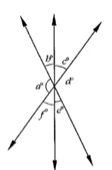If n=1+x , where x is the product of four consecutive positive integers, then which of the following is/are true? n is odd II. n is prime III. n is a perfect square. (a) I only (b) I and II only (c) I and III only (d) None of these
To solve the problem, we need to analyze the given statements about n, where n=1+x and x is the product of four consecutive positive integers.
Step 1: Define x
Let the four consecutive positive integers be represented as:
- m (first integer)
- m+1 (second integer)
- m+2 (third integer)
- m+3 (fourth integer)
Thus, the product x can be expressed as:
x=m×(m+1)×(m+2)×(m+3)
Step 2: Determine the parity of x
Among any four consecutive integers, there will always be at least two even numbers. Therefore, the product x will be even because the product of any even number with any other integer is even.
Step 3: Calculate n
Since x is even, we can express n as:
n=1+x
Since x is even, adding 1 to an even number results in an odd number. Thus, n is odd.
Step 4: Check if n is prime
To check if n is always prime, we can consider specific values of m:
- For m=1:
x=1×2×3×4=24⇒n=1+24=25(not prime)
- For m=2:
x=2×3×4×5=120⇒n=1+120=121(not prime)
Since we found examples where n is not prime, we conclude that n is not always prime.
Step 5: Check if n is a perfect square
We can express n in terms of m:
n=1+m(m+1)(m+2)(m+3)
To analyze whether n is a perfect square, we can rewrite x:
x=m(m+1)(m+2)(m+3)=(m2+3m)(m2+3m+2)
Let y=m2+3m, then:
x=y(y+2)
Thus:
n=1+y(y+2)=y2+2y+1=(y+1)2
This shows that n is indeed a perfect square.
Conclusion
From the analysis:
1. n is odd (True)
2. n is prime (False)
3. n is a perfect square (True)
Thus, the correct answer is:
(c) I and III only.
Let the four consecutive positive integers be represented as:
- m (first integer)
- m+1 (second integer)
- m+2 (third integer)
- m+3 (fourth integer)
x=m×(m+1)×(m+2)×(m+3)
Among any four consecutive integers, there will always be at least two even numbers. Therefore, the product x will be even because the product of any even number with any other integer is even.
Since x is even, we can express n as:
n=1+x
Since x is even, adding 1 to an even number results in an odd number. Thus, n is odd.
To check if n is always prime, we can consider specific values of m:
- For m=1:
x=1×2×3×4=24⇒n=1+24=25(not prime)
- For m=2:
x=2×3×4×5=120⇒n=1+120=121(not prime)
We can express n in terms of m:
n=1+m(m+1)(m+2)(m+3)
To analyze whether n is a perfect square, we can rewrite x:
x=m(m+1)(m+2)(m+3)=(m2+3m)(m2+3m+2)
Let y=m2+3m, then:
x=y(y+2)
Thus:
n=1+y(y+2)=y2+2y+1=(y+1)2
This shows that n is indeed a perfect square.
From the analysis:
1. n is odd (True)
2. n is prime (False)
3. n is a perfect square (True)
(c) I and III only.
Topper's Solved these Questions
Similar Questions
Given n=1+xandx is product of four consecutive integers. Then which of the following is true? I n is an odd integer II. n is prime. III. n is a perfect square. Only I is correct (b) Only III is correct (c) Both I and II are correct (d) Both I and III are correct
View SolutionFor the integer n , if n3 is odd, then which of the following statements are true? n is odd. II. n2 is odd. III. n2 is even (a) I only (b) II only (c) I and II only (d) I and III only
View Solution
Knowledge Check
- Question 1 - Select One
If n=1+x , where x is the product of four consecutive positive integers, then which of the following is/are true? n is odd II. n is prime III. n is a perfect square. (a) I only (b) I and II only (c) I and III only (d) None of these
AA and C onlyBA and B onlyCA onlyDNone of these - Question 2 - Select One
The smallest positive integer n for which (1+i)2n=(1−i))2n, is
A1B2C3D4
If x−y=8 , then which of the following must be true? Both x and y are positive. II. If x is negative, y must be positive III. If x is negative, y must be negative. (a) I only (b) II only (c) I and II (d) III only
View SolutionIf x and y are negative , then which of the following statements is / are always true? x + y is positive. II xy is positive. III. x y is positive. I only (b) II only (c) III only (d) I and III only
View SolutionThe least positive integer 'n' for which (1+i)n=(1−i)n holds is
View SolutionIn Figure, which of the following statements must be true? (i) a+b=d+c (ii) a+c+e=1800 (iii) b+f=c+e (a) (i) only (b) (ii) only (c) (iii) only (d) (ii) and (iii) only
 View Solution
View SolutionWhich of the following are equal in value? I. 41 II. 14 III. 40 IV. 04 a. I and II b. II and III c. III and IV d. I and IV
View SolutionIf n is a positive integer, then (1+i)n+(1−1)n is equal to
View Solution

